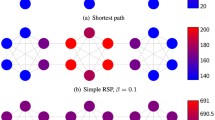Abstract
Traditional centrality metrics consider only shortest paths, neglecting alternative paths that can be strategic to maintain network connectivity. This paper proposes the disjoint multipath closeness centrality, a new metric to compute node centrality that extrapolates the traditional closeness to consider multiple shortest and disjoint quasi-shortest paths. The idea is to identify nodes that are close to all other nodes and are multiply-connected, which is important to perform high availability tasks. We limit the number of multiple disjoint paths using a connectivity factor \(\varphi \). We comparatively investigate the correlation between our metric, the traditional closeness, and the information centrality using social and communication networks. We also assess the node ranking obtained by each metric and evaluate node reachability when one or multiple network failures occur. The results show that our metric maintains high concordance with the other closeness metrics but it can reclassify at least 59% of nodes in the evaluated networks. Our metric indeed identifies better-connected nodes, which remain more accessible when failures happen.







Similar content being viewed by others
Notes
A preliminary version of this work was published in Portuguese at a Brazilian conference, SBRC 2019 [3]. Here, we improve the metric presentation and evaluation, using more networks, and adding the analysis of node reachability upon network failures.
References
Amaral P, Pinto PF, Bernardo L, et al (2017) SDN based traffic engineering without optimization: a centrality based approach. In: Communications (ICC), 2017 IEEE international conference on, IEEE, p 1–7
Aouiz AA, Hacene SB, Lorenz P (2019) Channel busyness based multipath load balancing routing protocol for ad hoc networks. IEEE Netw 33(5):118–125
Barbosa MSM, Medeiros DSV, Campista MEM (2019) Centralidade de proximidade por múltiplos caminhos disjuntos: Aplicação em redes de longa distância. In: SBRC, p 88–101
Bavelas A (1948) A mathematical model for group structures. Human Organiz 7(3):16–30
Bavelas A (1950) Communication patterns in task-oriented groups. J Acoust Soc Am 22(6):725–730
Bentley TG, Cohen JT, Elkin EB et al (2017) Validity and reliability of value assessment frameworks for new cancer drugs. Val Health 20(2):200–205
Berahmand K, Bouyer A, Samadi N (2019) A new local and multidimensional ranking measure to detect spreaders in social networks. Computing 101(11):1711–1733
Bondy JA, Murty USR, et al (1976) Graph theory with applications, vol 290. Citeseer
Borgatti SP, Everett MG (2006) A graph-theoretic perspective on centrality. Social Net 28(4):466–484
Bouet M, Leguay J, Combe T et al (2015) Cost-based placement of VDPI functions in NFV infrastructures. Int J Netw Manag 25(6):490–506
Brandes U, Fleischer D (2005) Centrality measures based on current flow. In: STACS, p 533–544
Buckingham FM (1969) The harmonic mean in forest mensuration. The Forest Chron 45(2):104–106
Comitê Gestor RNP (2007) Rede ipê: Política de uso. In: Report, Rede Nacional de Pesquisa
Couto RS, Secci S, Campista MEM, et al (2014) Latency versus survivability in geo-distributed data center design. In: 2014 IEEE global communications conference, IEEE, p 1102–1107
Croux C, Dehon C (2010) Influence functions of the spearman and kendall correlation measures. Stat Meth Appl 19(4):497–515
DANTE (2007) Géant: Transforming the way researchers collaborate. In: Report, DANTE
Freeman LC (1978) Centrality in social networks conceptual clarification. Social Netw 1(3):215–239
Grossi R, Marino A, Versari L (2018) Efficient algorithms for listing k disjoint st-paths in graphs. In: Latin American Symposium on Theoretical Informatics, Springer, p 544–557
Hayes B (2006) Connecting the dots. Am Scient 94(5):400–404
Hu ZL, Liu JG, Yang GY et al (2014) Effects of the distance among multiple spreaders on the spreading. EPL (Europhy Lett) 106(1):18002
Kendall MG, Smith BB (1939) The problem of m rankings. Annals Math Stat 10(3):275–287
Maccari L, Cigno RL (2016) Pop-routing: Centrality-based tuning of control messages for faster route convergence. In: Computer Communications, IEEE INFOCOM 2016-The 35th Annual IEEE international conference on, IEEE, p 1–9
Medeiros DSV, Campista MEM, Mitton N et al (2017) The power of quasi-shortest paths: \(\rho \)-geodesic betweenness centrality. IEEE Trans Netw Sci Eng 4(3):187–200. https://doi.org/10.1109/TNSE.2017.2708705
Nakarmi U, Rahnamay-Naeini M, Khamfroush H (2019) Critical component analysis in cascading failures for power grids using community structures in interaction graphs. IEEE Trans Netw Sci Eng. https://doi.org/10.1109/TNSE.2019.2904008
Newman MEJ (2006) Finding community structure in networks using the eigenvectors of matrices. Phys Rev E, 74:036104. https://doi.org/10.1103/PhysRevE.74.036104, https://link.aps.org/doi/10.1103/PhysRevE.74.036104
Newman MJ (2005) A measure of betweenness centrality based on random walks. Social Netw 27(1):39–54
Rossi RA, Ahmed NK (2015) The network data repository with interactive graph analytics and visualization. In: AAAI, http://networkrepository.com
Samadi N, Bouyer A (2019) Identifying influential spreaders based on edge ratio and neighborhood diversity measures in complex networks. Computing 101(8):1147–1175
Schafer V (2015) Part of a whole: RENATER, a twenty-year-old network within the internet. Inf & Cult 50(2):217–235
Stephenson K, Zelen M (1989) Rethinking centrality: methods and examples. Social Netw 11(1):1–37
Taylor WH (1933) The meaning of an average. J Educat Psychol 24(9):703
Author information
Authors and Affiliations
Corresponding author
Additional information
Publisher's Note
Springer Nature remains neutral with regard to jurisdictional claims in published maps and institutional affiliations.
Rights and permissions
Springer Nature or its licensor (e.g. a society or other partner) holds exclusive rights to this article under a publishing agreement with the author(s) or other rightsholder(s); author self-archiving of the accepted manuscript version of this article is solely governed by the terms of such publishing agreement and applicable law.
About this article
Cite this article
Barbosa, M.S.M., Medeiros, D.S.V. & Campista, M.E.M. Disjoint multipath closeness centrality. Computing 105, 1271–1294 (2023). https://doi.org/10.1007/s00607-022-01137-7
Received:
Accepted:
Published:
Issue Date:
DOI: https://doi.org/10.1007/s00607-022-01137-7




